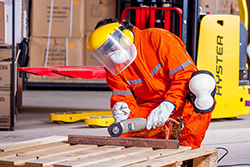 Employees who work in construction, carpentry, manufacturing, auto repair, welding and maintenance are most likely to experience eye injuries. However, almost every work environment contains eye hazards, and the Centers for Disease Control and Prevention reports that 2,000 people suffer from workplace eye injuries every day. As many as 400 of those accidents causes vision loss. The correct eye protection can prevent up to 90 percent of these accidents.
Employees who work in construction, carpentry, manufacturing, auto repair, welding and maintenance are most likely to experience eye injuries. However, almost every work environment contains eye hazards, and the Centers for Disease Control and Prevention reports that 2,000 people suffer from workplace eye injuries every day. As many as 400 of those accidents causes vision loss. The correct eye protection can prevent up to 90 percent of these accidents.
Common Causes of Workplace Eye Injuries
The most common causes of eye injuries include:
-
- Chemicals and cleaning products
-
- Tools
-
- Flying metal, glass, pencils, nails, staples, wood slivers and other objects
-
- Particles
-
- Harmful radiation
How do Eye Injuries Happen?
Eye injuries typically occur in three ways.
-
- Penetration occurs when a sharp object enters the eye and causes trauma.
-
- Burns damage the tissue in and around the eye. They are caused by chemicals or cleaning products and include thermal burns from welding.
-
- Striking or scraping involves small particles or objects and is the most common workplace eye injury. The offending material can affect the eye, eyeball or socket.
Ways to Prevent Eye Injuries
You and your employees can take several steps to protect sensitive eyes.
-
- Perform an eye hazard assessment. Walk around your business and identify any workstations, objects or other potential hazards.
-
- Eliminate as many hazards as possible. Work with your safety manager or insurance company to identify and remove the hazards you find.
-
- Install safety measures. Consider installing screens, machine guarding or engineering controls as well as other necessary safety precautions.
-
- Teach eye safety to your employees. Your team members should understand the potential dangers they may face on the job and the protective measures they should take.
-
- Provide proper eye safety gear. The gear you provide depends on your specific workplace hazards and on your employees’ personal preferences and needs. Examples include prescription and non-prescription safety glasses, side shields, goggles, face shields, helmets and full-face respirators. Be sure the safety lenses follow OSHA requirements, are comfortable and allow peripheral vision.
-
- Train team members on how to handle an eye injury emergency. Everyone should know where the eye wash station is located and how to use it.
-
- Continue to take eye safety seriously. Perform regular hazard assessments, update safety equipment and provide ongoing eye safety training.
-
- Update your Workers’ Compensation insurance. While you do your best to ensure workplace safety, accidents can happen. Your Workers’ Compensation insurance will pay for medical treatment and other related expenses if an employee suffers an eye injury on the job.
Workplace eye safety is important. Use these top safety tips to prevent as many eye injuries as possible.





